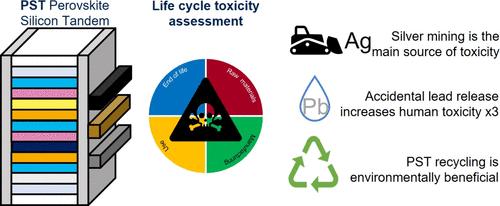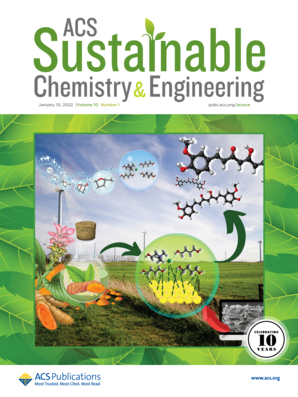Comparative Life Cycle Toxicity Assessment of Perovskite/Silicon Tandem Photovoltaics
IF 7.1
1区 化学
Q1 CHEMISTRY, MULTIDISCIPLINARY
引用次数: 0
Abstract
Perovskite/silicon tandem solar cells (PSTs) have emerged as promising photovoltaic (PV) technology that can exceed the theoretical power conversion efficiency limit of single-junction solar cells. To determine the future potential benefits of PSTs, it is crucial to accurately assess their environmental impacts and recyclability. Here, we present the first complete life cycle toxicity assessment of the PST panels. For this, we evaluated the toxicity of material procurement, manufacturing, and use stages and compared them with the toxicity of crystalline silicon PVs and CdTe PVs, as well as other electricity sources. For the end-of-life (EoL) stage, we developed three variants of panel recycling processes and compared their toxicity impacts with those of procuring the materials required to manufacture a new panel. We found that the life cycle toxicity of PV sin general is mainly driven by metal emissions. PSTs in particular emit more metals (and these are more toxic) than other PVs, but less than conventional sources of energy. A lower silver content─or more sustainable silver procurement─would be the first step toward making PSTs more environmentally sustainable. Concerning the EoL analysis, all proposed variants are less impactful than materials procured from the market. Their largest benefits can be found in the recovery of the bottom glass and crystalline silicon subcell, the copper cables, and the top glass.

Perovskite/Silicon Tandem Photovoltaics 的生命周期毒性比较评估
过氧化物/硅串联太阳能电池(PST)已成为一种前景广阔的光伏(PV)技术,其功率转换效率可超过单结太阳能电池的理论极限。要确定 PST 未来的潜在效益,准确评估其对环境的影响和可回收性至关重要。在此,我们首次对 PST 面板进行了完整的生命周期毒性评估。为此,我们评估了材料采购、制造和使用阶段的毒性,并将其与晶体硅光伏和碲化镉光伏以及其他电力资源的毒性进行了比较。对于寿命终结(EoL)阶段,我们开发了三种不同的电池板回收流程,并将其毒性影响与采购制造新电池板所需材料的毒性影响进行了比较。我们发现,光伏的生命周期毒性一般主要由金属排放驱动。与其他光伏产品相比,PST 的金属排放量更高(毒性也更大),但低于传统能源。降低银含量--或更可持续地采购银--将是使 PST 更具环境可持续性的第一步。关于环境效益分析,所有建议的变体都比从市场上采购的材料影响更小。它们的最大优势在于回收底部玻璃和晶体硅子电池、铜电缆和顶部玻璃。
本文章由计算机程序翻译,如有差异,请以英文原文为准。
求助全文
约1分钟内获得全文
求助全文
来源期刊

ACS Sustainable Chemistry & Engineering
CHEMISTRY, MULTIDISCIPLINARY-ENGINEERING, CHEMICAL
CiteScore
13.80
自引率
4.80%
发文量
1470
审稿时长
1.7 months
期刊介绍:
ACS Sustainable Chemistry & Engineering is a prestigious weekly peer-reviewed scientific journal published by the American Chemical Society. Dedicated to advancing the principles of green chemistry and green engineering, it covers a wide array of research topics including green chemistry, green engineering, biomass, alternative energy, and life cycle assessment.
The journal welcomes submissions in various formats, including Letters, Articles, Features, and Perspectives (Reviews), that address the challenges of sustainability in the chemical enterprise and contribute to the advancement of sustainable practices. Join us in shaping the future of sustainable chemistry and engineering.
 求助内容:
求助内容: 应助结果提醒方式:
应助结果提醒方式:


